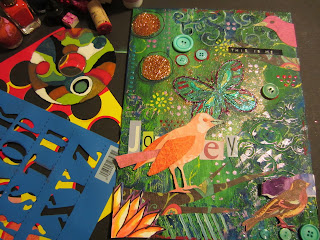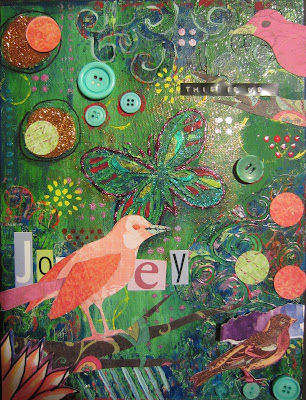I know full well that some of
you may be having difficulty with what to do next. I have that problem sometimes too. But let me assure you that you will get inspired again. For example, this next page that I have
completed. I looked at it and
wondered what it was that I was going to do with it. Then I just jumped in.
The page needed to be painted that is for sure. So I went ahead and painted it. Then I thought, what does it look
like? Then it hit me. The circles, the swirls, the paper in
the bottom right hand corner looked like bushes and then I knew. Yes, you’ve guest it, Van Gogh’s Starry
Night. Vincent Van Gogh’s work
still inspires artists today. I
can only hope that my work will still inspire people after I’m gone.
I didn’t plan on being inspired
by Van Gogh today but I was. The
more I do art, the more this happens to me. The piece of art that I am working on takes me on an unknown
journey. Not that it talks to
me. I am not losing me mind, but
when I am in the process of creating it, the way it looks at any given time,
dictates the next step. It’s very
cool.
Let me encourage you to ‘just
start’. Add something, look at it,
and add something else. Keep
trying new things, things that you like.
For example, if you like blues, then paint blues. If you like flowers, paint some
flowers. If you like block
letters, write some block letters.
If there are numbers that you like, then cut out some numbers. You get the idea.
Another way to get inspired
is by looking at other artists’ work.
Under no circumstances am I telling you to copy someone else’s
work. Yuk! Definitely no no. But you can be inspired by other’s work
just like I was inspired by Van Gogh’s Starry Night today.
Also, there are many prompts
to get you going on the internet.
Not to mention the prompt that I give you. You may just want to start writing about a prompt and before
you know it images pop up in your head and you start drawing, cutting, gluing,
etc.
Make sure that you have
collected things that YOU like to help you create your pages. When you go through your day, look
around for items that you may want to use. For example, you are in the lunchroom and you happen to
notice a pretty colored wrapper around someone’s food. Ask if you can have it. You may take a flower from your garden
and dry the petals and leaves out to use in your journal. Flipping through magazines is a good
way to find images/colors that you like.
Advertising and Marketing are big money makers. That’s why there are great images
around you. You just need to be
aware of them and use them.
Sometimes I just start
doodling and then images appear.
Then I start developing them and before I know it, it starts to have a
life of it’s own. Just let your
pen or pencil wonder. You’ll start
to see things too.
Don’t get discouraged. Brilliant ideas are bound to come to
you. Somebody may say something to
you, or you’ll be listening to a song, and it will be enough to inspire you. Don’t forget to write down inspiring
thoughts and images when you hear or see them. Keep them handy for the future when you are looking for
inspiration.
So back to my page
today. As I said earlier, I
just started painting my page with colors that I like. After gazing at it for a few minutes, I
was set on using Van Gogh’s Starry Night as my inspiration. I was wondering what I could use for
swirls. I just recently learned
how to quill so I started slicing up paper about ¼ inch wide and 6 inches
long. Apparently WalMart has a
shredding machine for $10.00. I’ll
need to run by and grab one.
Anyways, I then rolled the ends around a paint brush in opposite
directions. Pick paper that has
some body to it. I loosened the
swirls a little and then started placing them around the circles and swirls of
yarn.
When I thought about Van
Gogh’s Starry Night, I thought about his bush and the movement he created in it
by swirling his brush strokes. I
took some more cut paper and placed it on top of the textured looking bush in a
curving fashion.
The peaks at the top of the page relate to the mountains in his work, and the rectangles on top of the peaks relate to the buildings.
The peaks at the top of the page relate to the mountains in his work, and the rectangles on top of the peaks relate to the buildings.
I cut out a couple of moons from yellow colored paper and placed them on pieces of accordion folded paper for the unexpected.
The cones I created came to me when I remembered that Van Gogh was hugely inspired by the Japanese artists. The cones remind me of the conical hats that the Japanese wore. You make these hats simply buy cutting a circle, slice it halfway across the diameter of the circle, add a dab of glue on one side of the slit, and pull the other side of the slit over the glue until you form a cone.
Lastly, I wanted to show you something I saw while working on my page. I was almost done with my page except that it felt unbalanced to me. The bottom right hand corner of the page was too dark and heavy. It needed some lightening up. So I drew a few Japanese inspired flowers with a Sharpie, and then used watercolor to paint them. Sharpie does not bleed when wet making them ideal to use with watercolor. Placing them on the bottom right hand corner did the trick. It felt balanced to me then.
My journal pages have lots of dimension to them and my books are bulging, but I love it. As long as you don’t sit on your book, your images shouldn’t flatten. Handle with care!
PROMPT FOR THE WEEK
Tough Times?
If you are human, and if you
are lucky enough, you will experience rough times in your life. Yes, it was not a typo, you are lucky
to experience rough times in your life.
Why? Because it is through
the tough times that we learn and grow.
Times of successes and triumphs become catalysts to positive
transformation in life, but so do times of difficulty.
It’s difficult to go through
life without experiencing some kind of hardship. It could be a loss of a job, loss of a marriage, loss of a
friend, or maybe a loss of a loved one.
Whatever the loss is, it is an extremely significant experience. I believe, and for myself, these are
the times when people grow the most.
Of course it is not pleasant when these hardships come, and there is
always a time of grieving, disappointment, and heartache, but the potential
positive transformation that is possible from these experiences far exceed that
of the transformation achieved from our times of successes and triumphs. It is almost as if someone has thrown a
big bucket of iced cold water at you and suddenly, almost violently, you wake
up from a time of slumber and become very aware of the fact that you have been
asleep, and that your life no longer makes sense. It is at this point that you are forced to re-evaluate your
life and hopefully make it better.
It’s like you have been given a second chance, and that you can start
brand spanking new.
Looking back, I realize that the
greatest challenges that I have experienced have defined me as to who I am
today. Without them, I would still
be skimming life, letting life control who I am instead of taking control and
directing my own life.
Friend, don’t be afraid of
difficult and trying times in your life.
I encourage you to use these times for growth. Times to re-evaluate and renew.
Believe it or not, we really
do care about you.
We will resume the journal project on July 9th, enjoy your Fourth of July Celebrations!
We will resume the journal project on July 9th, enjoy your Fourth of July Celebrations!
Dear
brothers and sisters, when troubles come your way, consider it an opportunity
for great joy. For you know that
when your faith is tested, your endurance has a chance to grow. James 1:2-3



















.jpg)









































